Onigiri in the movies: Kamome Diner (Seagull Diner) and Supermarket Woman
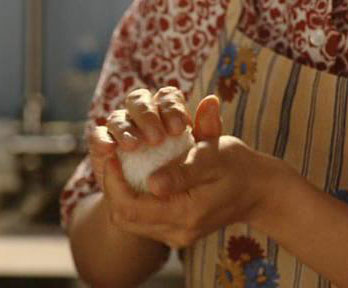 Whenever I am feeling blue, one of the foods that I crave is onigiri. You could just chalk that up to the fact that it's mostly rice = carbs and I'm just craving a carb fix. But it really goes beyond that. It's tied to memories of my aunts making row upon row of perfectly shaped onigiri for a family gathering, and the salty tinge on my lips from the giant onigiri my mother made for me for a school outing.
Whenever I am feeling blue, one of the foods that I crave is onigiri. You could just chalk that up to the fact that it's mostly rice = carbs and I'm just craving a carb fix. But it really goes beyond that. It's tied to memories of my aunts making row upon row of perfectly shaped onigiri for a family gathering, and the salty tinge on my lips from the giant onigiri my mother made for me for a school outing.
Two of the most popular articles here on Just Hungry are the ones about onigiri. It's great to see so many people from around the world enjoying this quintessential Japanese comfort food.
There are two very interesting Japanese movies where onigiri play a starring role, in quite different ways; Kamome Diner (Kamome Shokudoh) and Supermarket Woman (Suupaa no Onna). Although neither seems to be available on DVD in English speaking countries yet, I thought I'd talk about them a bit.
Suupaa no Onna: Anatomy of a Japanese grocery store
The first is a comedy from 1996, Suupaa no Onna (Supermarket Woman). It's directed by Juzo Itami, better known as the director of the 'noodle Western' classic Tampopo, and as with most of his movies stars his wife, Nobuko Miyamoto. Miyamoto plays Hanako, a 40-something widowed woman who wanders into a run down small suupaa, a local supermarket, which happens to be run by her childhood friend Goro, a widower played by Masahiko Tsugawa. The suupaa is called Sho-jiki Ya, ("Honest Goro" in the English subtitles). Sho-jiki ya is teetering in the edge of failure because a brash competitor called Yasuuri Daimaoh ("Bargains Galore" in the subtitles). Hanako, who keeps insisting she's "just a housewife with a housewife's wisdom", is a supermarket expert with a sharp eye and strong opinions about how a supermarket should be run. In short order she's hired by Goro, first as the head cashier, then as the assistant manager of Sho-jiki Ya. Together with Goro, she must fight the corrupt figures behind Yasuuri Daimaoh to prevent Sho-jikiya from going under.
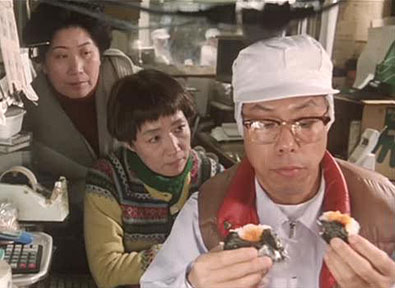
One of the store sections that Hanako attempts to improve is the osouzai deparment. Osouzai means ready-made meal items, and busy people in Japan rely on these to round out or even make up a whole meal. A popular osouzai product is of course, onigiri. Hanako discovers that the onigiri sold at Shoujiki-ya are under-par, using inferior fillings, and convinces everyone involved that that is just not right. At first the onigiri supplier is reluctant to spend more to improve the onigiri, but once he sees how happy the better tasting onigiri makes the housewife-taste testers, he is overcome by the joy of making his customers happy.
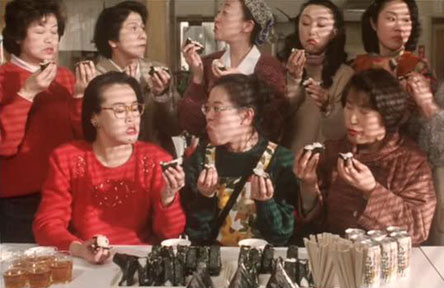
Suupaa no Onna is part of the "Fighting Women" series of movies that Juzo Itami made in the '80s and '90s, such as Marusa no Onna (A Taxing Woman) and Minbo no Onna (known among other titles as The Anti-Extortion Woman). Like those movies, the general theme is that of the fiesty, honest heroine who has the courage to stand up against a corrupt establishment. While the other titles in the series have been released on DVD in the U.S. and elsewhere, Suupaa no... never really made it outside of Japan. It's a shame, since it's a lot of fun even if it didn't feature food as a main character. [Update:] It's now available in the U.S. on Amazon.com! Yay! For food lovers, it's a fascinating if broad (and now somewhat outdated) view of Japanese grocery shopping, from the store's point of view and the buyer's point of view - the buyers in this case being the all-mighty, no-nonsense Japanese housewife. It may not be as profound as Tampopo or have as much universal appeal, but for anyone interested in Japanese culture or food or even supermarkets, I highly recommend it. (See notes at the end for some more.)
Kamome Shokudoh: Japanese soul food in Helsinki
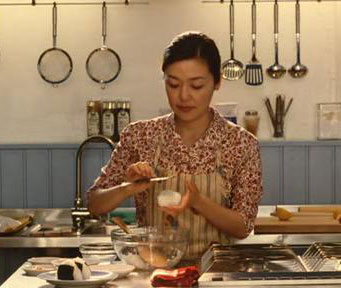
Made 10 years after Suupaa no Onna in 2006, Kamome Shokudo (Kamome Diner, or Seagull Diner) a very different movie. It's the story of a woman called Sachie, played by Hairi Katagiri, who opens a small Japanese restaurant/cafe in Helsinki, Finland. At first people just look curiously in the windows, but don't go in. Then one day a young Japan otaku teenager wanders in...
For Sachie, onigiri are "Japanese soul food". She is convinced that she can make Finnish people love her Japanese soul food, because she reasons that "a country with such a sense of humor and a relaxed view of life must appreciate good food". At one point, worried about the lack of customers, she and another Japanese woman who somehow wanders into the restaurant and ends up staying on as a waitress test out some alternative fillings that they think may appeal more to Finnish people, like reindeer meat, crayfish and pickled herring. The taste tests fail though, and Sachie reaffirms her conviction that the "traditional fillings" of ume, shake, okaka (umeboshi, salted salmon, bonito flakes moistened with soy sauce), are the best. While the subject of alternative fillings for onigiri does crop up from time to time, I have to say I tend to agree with Sachie here! Sachie's goal is to for her Finnish customers to appreciate real Japanese soul food.
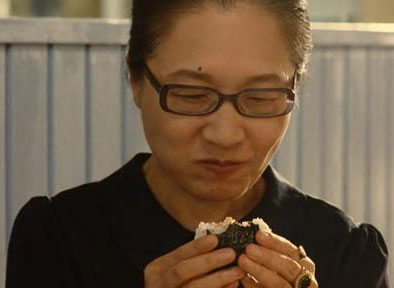
Kamome Shokudoh is a gentle, rather fairytale-like movie, with touches of magical realism. Nothing much really happens, but the main characters still go through some profound changes. I don't want to give away too many plot details since there are so few really. A lot of people won't enjoy it for that reason. I loved it however. It's not as obvious a look at Japanese culture as Suupaa no Onna is, but it does show a certain very Japanese view of life. It also has lots of great shots of typical Japanese homestyle dishes, and the Scandinavian interiors are gorgeous.
Notes about Suupaa no Onna
- Goro and Hanako are used as generic names for girls and boys, sort of like Jack and Jill or Dick and Jane in English.
- Tampopo fans may remember Masahiko Tsugawa, who plays Goro, as the convenience store manager who has a frantic cat-and-mouse chase around his store with the old lady who likes to squeeze the produce.)
- The direct translation of Sho-jiki Ya is Honest Store. Yasuuri Daimaoh is Bargain Devil (a Daimaoh is a sort of spirit, that can be but isn't always evil).
- Great news! Supermarket Woman is now available in the U.S. on Amazon.com!
Notes about Kamome Shokudoh
- Why does Sachie, not to mention the other Japanese women in the movie, end up in Finland? Why does the story even take place in Finland? The answer in a nutshell is Moomin. Moomin is tremendously popular in Japan; Moomin books are perpetual bestsellers, and many a young girl daydreams about 'going to Moomin land'. By extension, Finland, the land of Moomin, is seen in quite a romantic light. Now since I haven't read Moomin since...ah, I'm actually not sure if I ever read Moomin...I can't say I understand the appeal but there it is. (Moomin fandom in Japan is oddly similar to Anne of Green Gables fandom.)
- This movie was released in Finland under the title Ruokala Lokki. (It could be available in Finland on DVD, but since I don't read any Finnish I can't find out.)
- This one is also only available as a Japanese release. It does have English subs. (I've seen cheap versions on eBay but I'm skeptical about the legality of those.) Amazon Japan link.
If you enjoyed this article, please consider becoming my patron via Patreon. ^_^

 Welcome to Just Hungry, where we serve authentic Japanese recipes and more! I'm
Welcome to Just Hungry, where we serve authentic Japanese recipes and more! I'm 














Comments
sea
22 March, 2007 - 01:57
Permalink
suppa no onna
Ok- since it's spring break and I was looking for something to do- I went to the local Japanese video store and picked up Suppa no Onna and Kamome Shokudoh. Actually I was pretty thrilled that they carried them both... They only had them on video (no DVDs at this place) so no subtitles, but it's good for me to watch them without anyway. :) I actually haven't seen Juzo Itami's other movies, except for tampopo, but I've seen them in the video store- and now I realize I really ought to watch them. So far I've just watched Suppa no Onna, but it was fun. Gave me a different perspective on japanese supermarkets, besides that of just a consumer. Also fun to laugh at the 80's-early 90's clothing- heh heh.
Thanks for the tip! ;)
-Sea
PS Oh, and when my mother in law visited us in Japan, I think she had the best time at the supermarket, of all places. She was practically giddy. I have to admit, it is interesting to visit international supermarkets and get a bit more of a feel for everyday life. I had fun myself, in the supermarket in Bangalore. :)
Donna
25 March, 2007 - 06:39
Permalink
I was able to see Kamome
I was able to see Kamome Shokudoh with subtitles a few months ago--it is a lovely, gentle movie. I enjoyed watching Sachie make the onigiri, her technique gave me some tips on improving my own. Also, the Moomin influence shows up in the movie-when she meets the first Japanese tourist, she is reading a moomin book. I think Finland is also the closest European country to Japan.
Thanks for the recommendation for Suupaa no Onna, it's next on my list to watch.
karaimame
18 January, 2009 - 14:17
Permalink
Kamome Shokudo- Ruokala Lokki
Onigiri gives me also so good memories. Mom usually made a batch of them (simple umeboshi filling) to our picnics and when we went to seaside. It was great.. Now that I think she needed to wake up rather earlier than us to prepare everything for the trip, makes me just admire her...
About the movie Ruokala Lokki. Yes, it is available in Finland (finnish and swedish subtitles), in almost every DVD store. I bought my dvd in the supermarket nearby. :)
One can buy from internet too, at for example Filmifriikki (http://www.filmifriikki.fi/~BrH6x0000001/?Y999=PIF&Y104=006415750013219), http://cdon.fi/search?q=ruokala%20lokki&gclid=COur_bKZmJgCFQoh3god9xldnA or check up in big supermarkets and shopping centers.
Very nice recommendations! I must check for the Suupaa no Onna.
maki
20 January, 2009 - 00:24
Permalink
Re: Kamome Shokudo- Ruokala Lokki
I'm rather curious - what do Finnish people think about Kamome Shokudo?
karaimame
21 January, 2009 - 19:50
Permalink
Re: Kamome Shokudo- Ruokala Lokki
Hmm.. I am not Finnish, but I liked it a lot. First, because it was taken in the place where I live, second.. well because it is Japanese, so I was interested to see this combination , specially when the things involved were food and culture differences (and foreign people living in Finland).
Well.. I asked my husband what did he think about the movie and he , the man of brief words, said "it is nice". ehehe
At the time the movie was on theaters, there was some sort of "hype" around it. There were reviews in newspapers, magazines and tv programs. Markku Peltola ( the actor who teaches the magic for the coffee) is quite known here (he appears in a movie from Finnish director Aki Kaurismäki).
Maybe I´ve noticed and saw all these, because I knew about the movie´s existance.
What we really liked in the movie, and it might be what other Finnish people might think about it, is the thing about simplicity . Let´s say that not much happens in most of it, but the way things are shown there, makes it quite beautiful.
Besides.. Helsinki in summer is so pleasant :)
Well.. let´s see if some real Finn come here and give any opinion about it ;).
Enk
1 April, 2009 - 01:15
Permalink
Re: Onigiri in the movies: Kamome Diner (Seagull Diner) and ...
Just a note: Sachie and the "gigantowoman" meet up in the cafe at the Akateeminen bookstore in downtown Helsinki called Cafe Aalto. The whole building was designed by Alvar Aalto.
Thanks for the good posts. I really miss eating readymade onigiri (and nikuman!).
Daniele 40yo ma...
4 June, 2009 - 10:35
Permalink
Onigiri & movies
Hi
I think Kamome shokudo is an incredibly beautiful great movie with a simple plot.
I ate a lot of home-made onigiri in my last trip to Japan (January '09).
Simple and delicious.
So it seems I like simple things.
But my mind can't avoid to point out: what is onigiri about let alone the Japanese long time tradition and the meaningful personal memories of each Japanese?
I hate to put it down to earth but isn't it just boiled white rice in a nice shape?
Add taste with nori and in some cases with a filling, but still..
In "Cutie honey - the movie" (2004) the main character gets its huge power by eating big amounts of her favourite food - guess what?!
Keep on the good job!
maki
4 June, 2009 - 10:58
Permalink
Re: Onigiri & movies
Well, isn't pasta just flour and water and maybe eggs or something in a nice shape?
Isn't bread flour and water and yeast or something in a nice shape? ...
I hope you get the idea now :)
Daniele 40yo ma...
5 June, 2009 - 10:30
Permalink
Re: Onigiri & movies
I am afraid I don't get it yet:
of course this is not about "Italian food vs. Japanese food" but still I think bread is more than flour and water , as well as pasta. The process of preparing bread (yeasts choice, dough making, fermentation, oven baking) adds a lot to it.
And about pasta, the dressing is half of the dish, you don't eat pasta alone. "Pasta" isn't exactly the name of a dish, but the name of an ingredient..
Anyway onigiri is much easier to prepare and handy to eat. And it is fun!
(sorry about this Italian-food offtopic!!)
maki
5 June, 2009 - 11:32
Permalink
Re: Onigiri & movies
Yep, you really don't get it I'm afraid.
It's cultural I suppose. Rice is of supreme importance in Japanese culture. A well made onigiri is not a simple 'ball of rice' to a Japanese person. A great tasting onigiri is about the quality of the rice, from the way it's grown to the way it's cooked and prepared. It is no accident that the word for 'meal' in Japanese, gohan (ご飯)also means (cooked) rice.
I was trying to draw an analogy of what I think is the position of bread in European culture - where it's called the 'staff of life' and to share a meal is called 'breaking bread' with someone and so on. Rice has as equal an importance in most Asian cultures, specifically in Japanese culture, and the onigiri is one of its purest forms.
So, please don't belittle another culture's icons just because you can't relate to it yourself.
Daniele 40yo ma...
5 June, 2009 - 11:49
Permalink
Re: Onigiri in the movies: Kamome Diner (Seagull Diner) and ...
Thank you Makiko for your kind explanation.
I have to say I had no intention at all to belittle a food I like and a culture I admire, so I apologize for my poor English if I sounded that way.
I only wanted to understand better something I am interested into, by trying to set up a rational analysis on the subject (perhaps too simplicistic).
So far, I understand the value of onigiri is about the quality of the rice, and about the way it is prepared and cooked (which I'd like to know).
Besides, as I previously supposed, its value as a cultural icon - but that is not a taste matter, right?
Misusan
16 June, 2009 - 09:46
Permalink
Re: Onigiri in the movies: Kamome Diner (Seagull Diner) and ...
I saw Ruokala Lokki with my sister. I think it had funny scenes :D but I was disappointed when I heard they only sell Finnish food in there (with high prices)
all in all the movie was good
Melissa
17 May, 2011 - 06:07
Permalink
Re: Onigiri in the movies: Kamome Diner (Seagull Diner) and ...
Onigiri is not just about the quality of the rice--it has a lot to do with balance of ingredients (salt on outside, amount and flavoring of filling, size and crispiness of the nori) and the texture created by the maker. I once watched an hour long tv program in Japan in which they taste-tested various people's onigiri and worked out the best techniques for making them. If one were to compare to Italian food, one might compare to the perfect oil and garlic spaghetti: easy to prepare, difficult to master.
anon.
18 June, 2012 - 21:09
Permalink
Re: Onigiri in the movies: Kamome Diner (Seagull Diner) and ...
FYI:
I think Sachie is played by Satomi Kobayahi, not by Hairi Katagiri.
Joie
16 October, 2012 - 05:13
Permalink
Re: Onigiri in the movies: Kamome Diner (Seagull Diner) and ...
Maki, may I know where you got the Kamome Diner stills from? I want to feature a few scenes from the film for an article I'm writing and my publishing company has strict copyright policies. I've been trying to find a way to contact the film production company but I can't find the email for their press office. I'm hoping you could help me!!
Thanks so much and sorry for the trouble!!
Joie
AVT
26 July, 2015 - 20:18
Permalink
Kamome diner with English subs
http://www.dramanice.tv/kamome-diner/watch-kamome-diner-episode-1-online